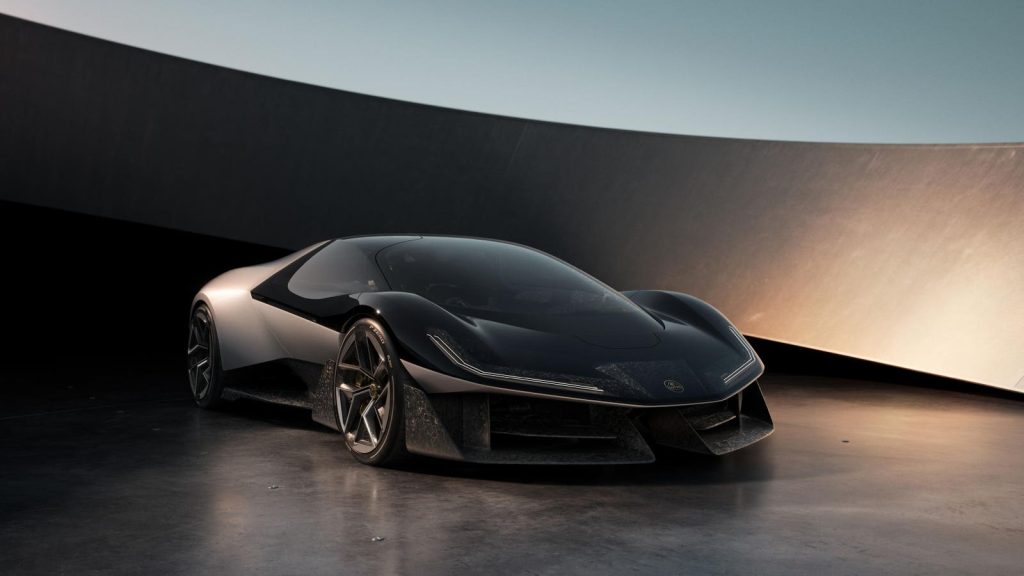Lotus used to be famous for small, light sports cars like the 1960s/1970s Elan and 1990s-onwards Elise. In the electric era, however, some have argued that the company has lost its way. The Eletre SUV and Emeya sedan aren’t exactly insubstantial, and they aren’t sportscars either. With the Theory 1 concept, Lotus intends to set the record straight: it can make electric performance cars that thrill on every level like its combustion vehicles of old.
Lotus’s first EV was a sportscar. The Evija was released in 2020 at Goodwood SpeedWeek, but it weighs nearly 1,900kg, has a run of just 130 units, and costs around $2.3 million. Despite stunning looks, it has been overshadowed by the likes of the Rimac Nevera and Pininfarina Battista. In contrast, over 35,000 Lotus Elises have been produced, it never weighed much more than 900kg, and the price was much more “affordable”, at least by sportscar standards.
With the Eletre and Emeya, under the wing of its Chinese parent company Geely, Lotus has been aiming for bigger market than the Elise. But to do so it has had to focus on more mainstream sectors than two-seater sportscars. The SUV is unfortunately such a large portion of the global market that this format was unsurprisingly the first foray with the Eletre. As SUVs go, it’s brilliant to drive, particularly the R. The Emeya is reportedly even better. But that’s still a large 2.5-ton plus sedan.
When I talked to Lotus at the Emeya launch at the end of last year, however, Vice President of Design Ben Payne hinted that “lighter, tighter and more focused products” would be coming. The Theory 1 is the first example of this. It isn’t an Elise successor, but as a concept it harks back towards the Lotus past much more than the Eletre, Emeya, and even the Evija.
The company talks about the Theory 1’s “DNA” – in this case standing for Digital, Natural and Analog. At first glance this looks somewhat paradoxical, since digital is the opposite of analog and not considered natural either. However, Lotus’s DNA is intended to show an emotional tension between these three. After all, diehard gearheads cite the lack of emotion of EVs as being their primary reason for hating them. Jeremy Clarkson, in the last ever Grand Tour episode “One for the Road”, implied the rise of the “appliance” EV was a significant factor in him calling it a day with automotive TV.
The Theory 1 isn’t trying to appeal to gearheads with artificial noise generators faking a roaring combustion engine, however. Mate Rimac has even gone so far as to partner a V16 naturally aspirated combustion engine with a potent electric drivetrain in the Bugatti Tourbillon, in large part to provide the drama of sound alongside the performance of electric. Instead, the Lotus approach has always been technological, particularly when racing, and the Theory 1 fits that heritage well.
As a fast EV, it’s not exceptional on paper. The current proposal is for a 70kWh battery delivering around 250 miles of range, not too different to a mainstream EV sportscar like the MG Cyberster. The 0-60mph sprint will be delivered by the 1000PS motors in “under 2.5 seconds” and onwards to a 200mph top speed, meaning a Tesla Model S Plaid would out-drag it.
Lotus sportscars were never about raw straight-line acceleration, though. The Elise was quick, but not THAT quick. Instead, the original car weighed just 725kg, meaning it would catch much more potent but heavier vehicles on the corners. Lotus is targeting a weight of under 1,600kg for the Theory 1, which isn’t exactly skinny but by EV standards is positively emaciated. Most supercars weigh around 1,500kgs, such as the Maserati MC20, without the power or torque of all-wheel drive electric motors. Aerodynamics are of course thoroughly optimized in the Theory 1 too. If Lotus can deliver on this promise, a car based on the Theory 1 could be a track monster to challenge any combustion-powered competitor.
One way Lotus has always provided innovation is in its use of materials, with the 1960s Elan employing fiberglass to deliver a 680kg body weight. The Theory 1 is made of just 10 elements, with liberal use of recycling, such as chop carbon fiber for the tub, cellulose composite and polycarbonate for the body, and recycled glass for the windows. To keep construction simple, the battery and motor are part of a stressed member, negating the need for a subframe.
For added drama, no self-respecting super/hypercar these days would be complete without scissor doors. The Theory 1 goes one further by having them open by sliding backwards as well as upwards. It’s a three-seater like the McLaren F1, with the driver sitting forwards in the middle. The Theory 1 is packed with similar intelligent driving technology to the Eletre and Emeya, using a full complement of cameras and sensors – unusual for a serious sports car. The rearview mirrors are replaced by small camera wings and screens. The lights are “laser wires”, using two thin strips floating inside the lens body to provide forward illumination.
Most importantly, Lotus is trying to create an immersive driving experience, in the absence of a raucous combustion engine, using its LOTUSWEAR™ system. This includes MotorSkins robotics built into the driver’s seat that give little nudges through the cushions, for example to deliver blind spot warnings. The steering wheel integrates a screen with transparent touch buttons. The headrest includes built-in speakers for the KEF audio system.
The overall result is a vehicle that is unashamedly electric and technological, but in a way that is not meant to overwhelm you with cockpit complications. Instead, the experience is intended to remain organic. The incredible Rimac Nevera has a reasonably pared back cabin, helping you concentrate on the fun bit – driving – but the Theory 1 goes further, both with the simplicity and the technology.
Of course, it’s still a concept car, and there’s no word when or if it will go into production. The clue is in the name – it’s a theory. It’s a demonstration of what could be possible. But it’s much more than a concept of a theory. Lotus is really showing where it intends to head as it goes all-electric by 2028. If it can deliver even half of the Theory 1 concept, Lotus could finally achieve what we expect in an electric sportscar from the brand.
Read the full article here










